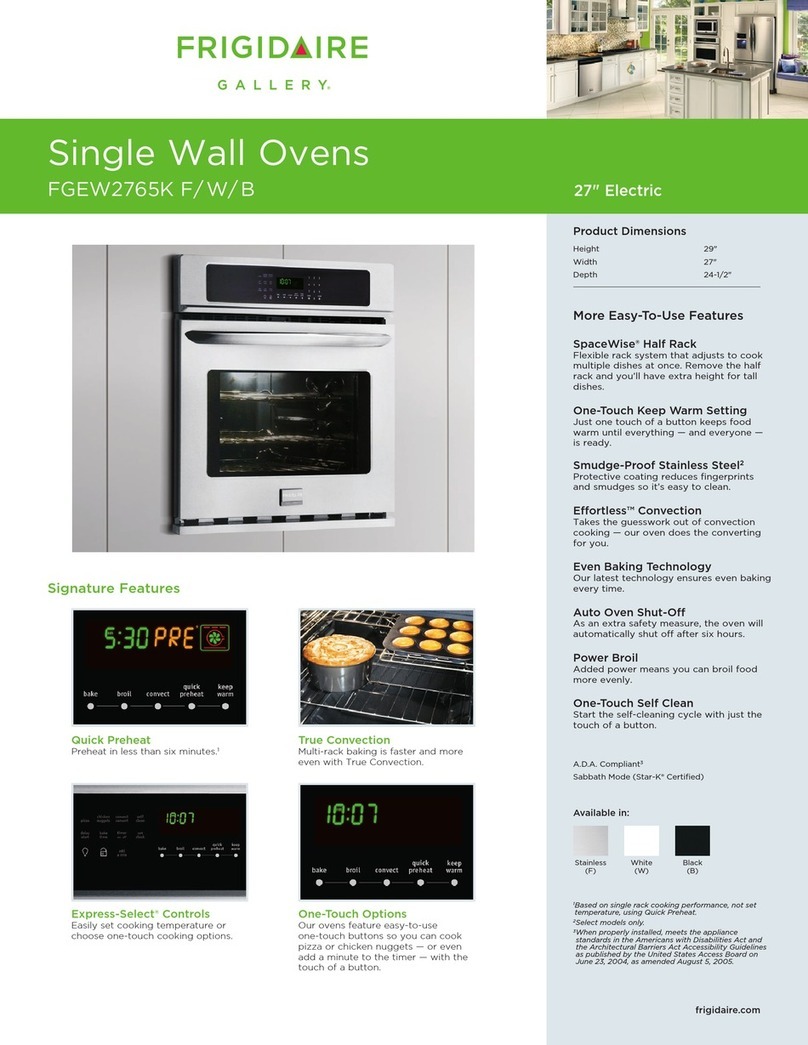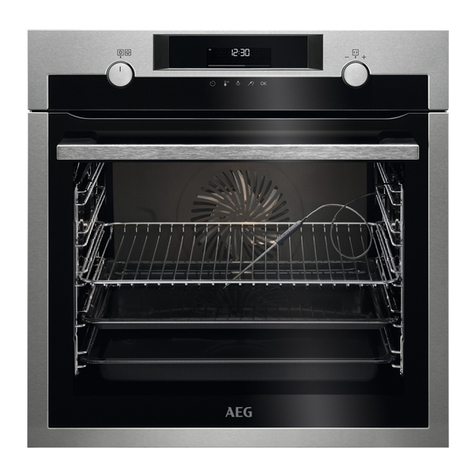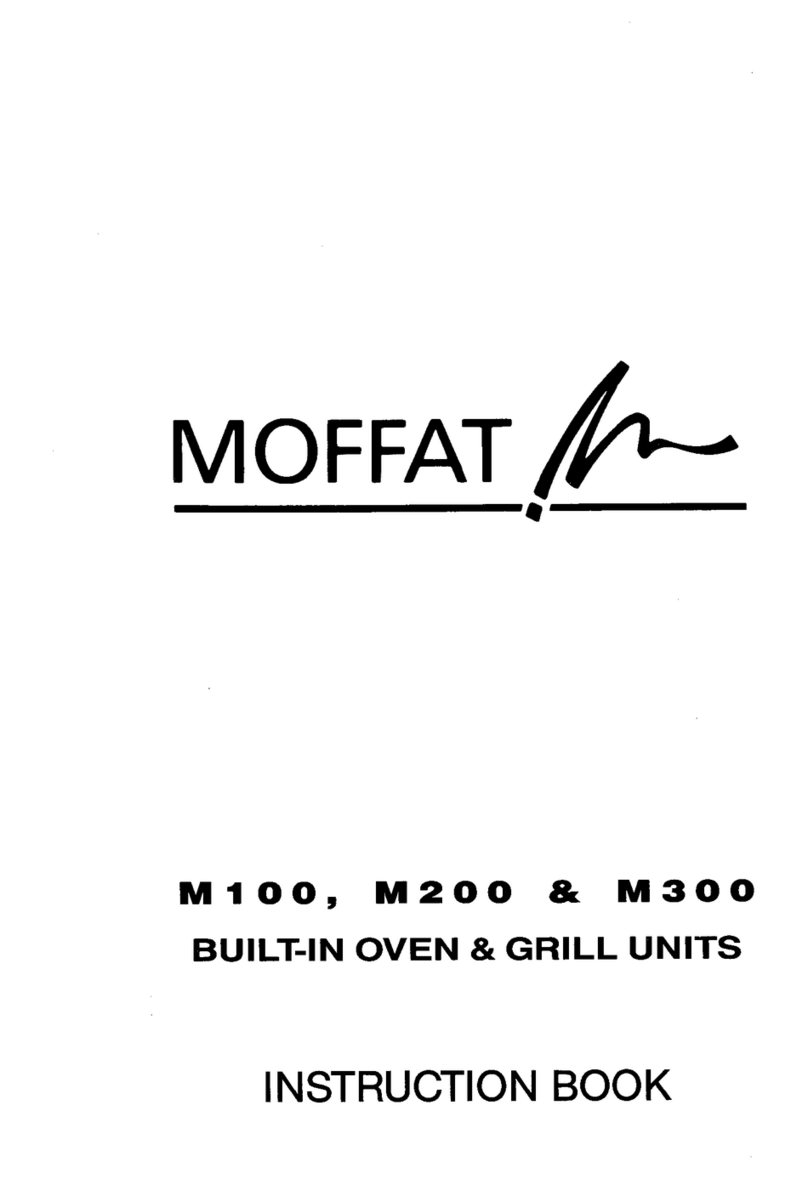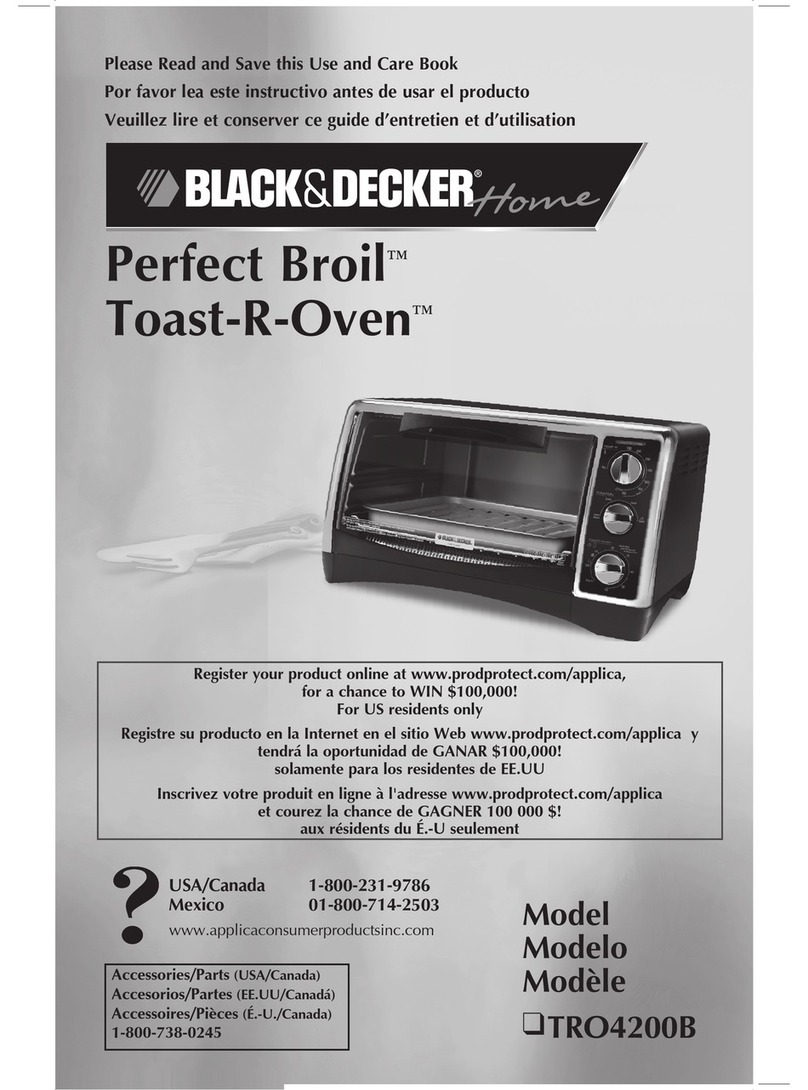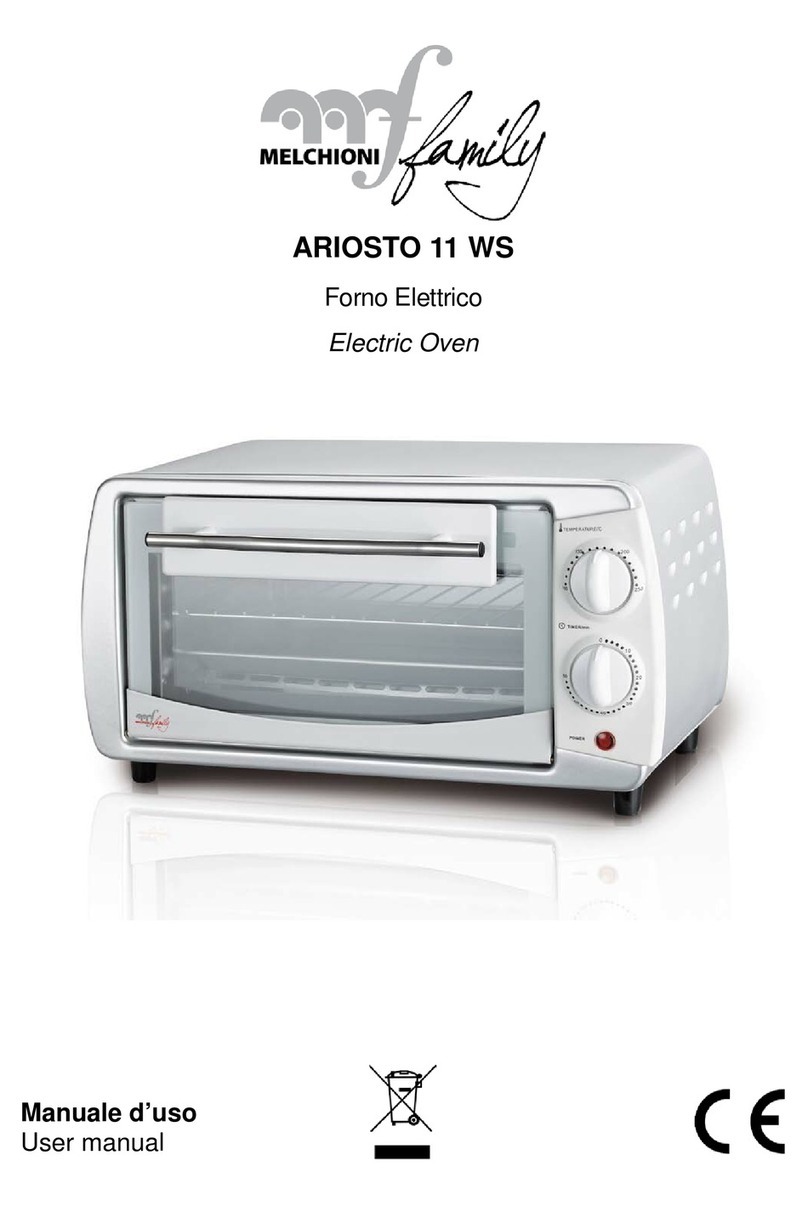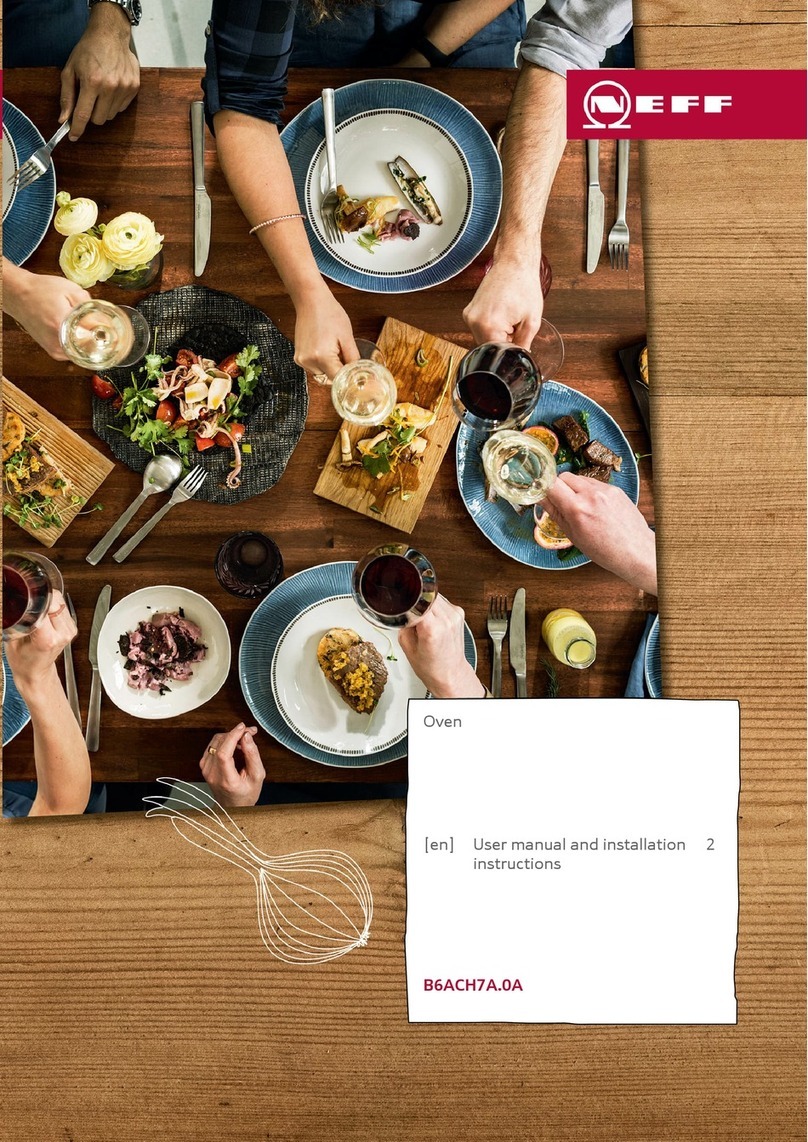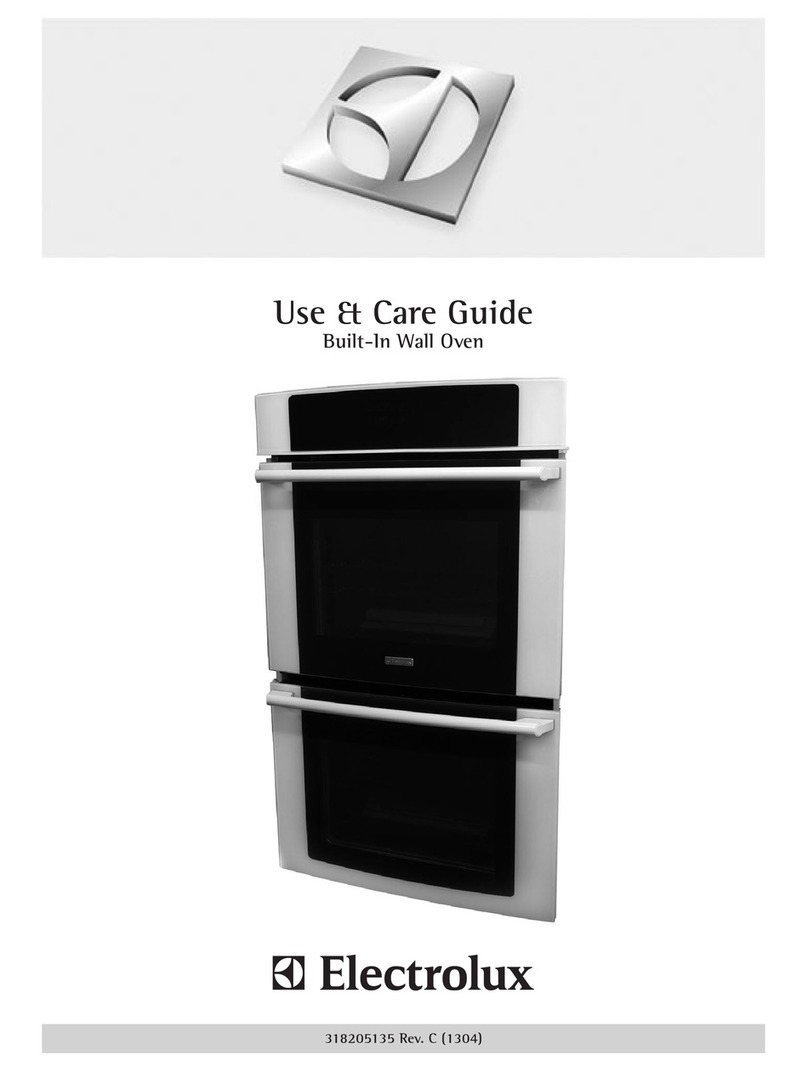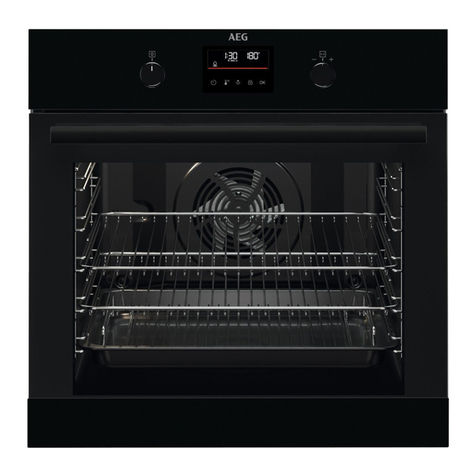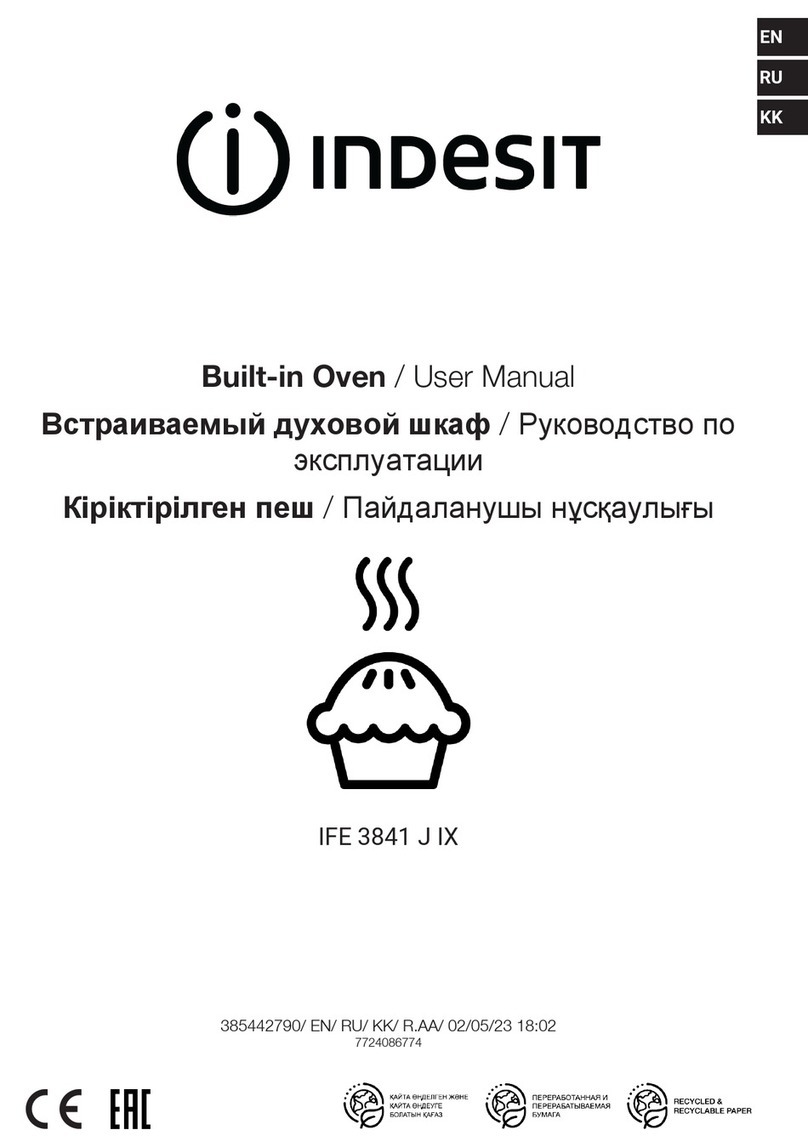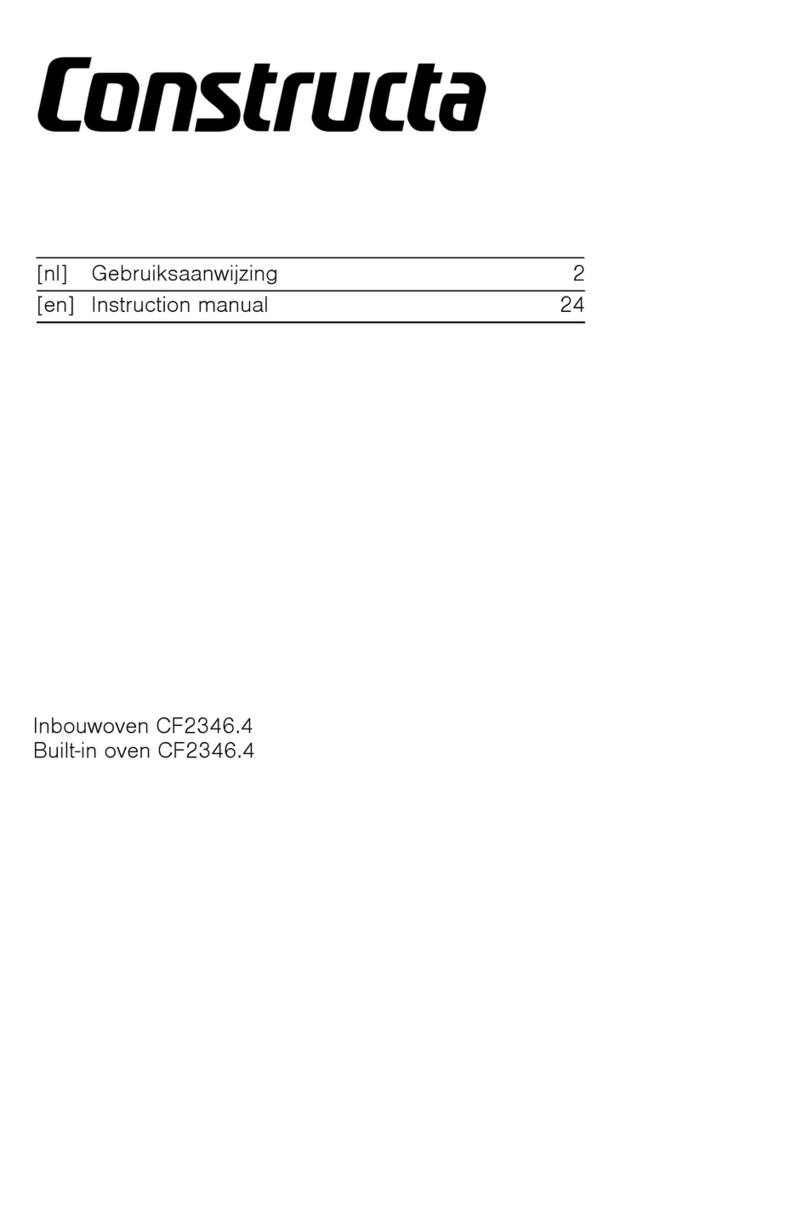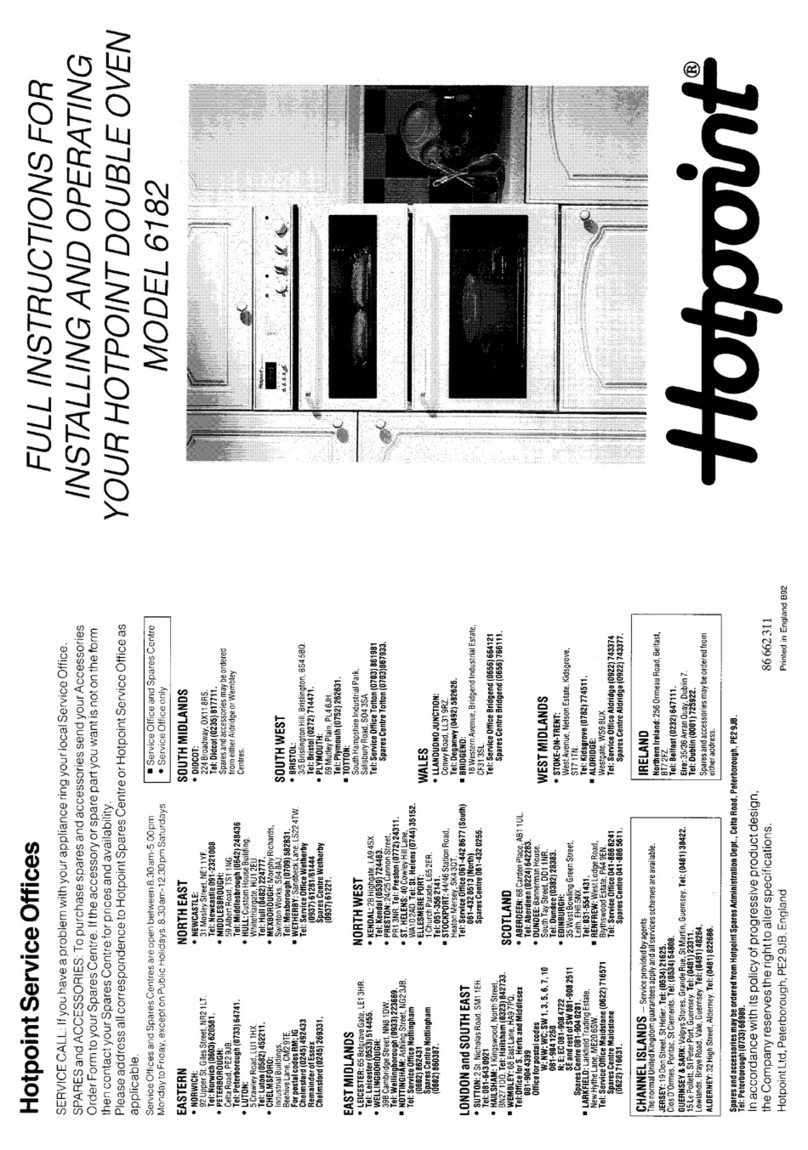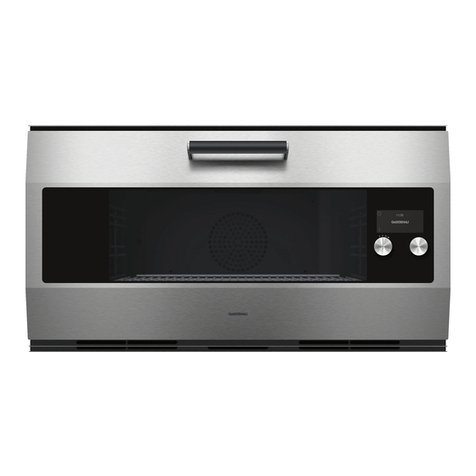Giles & Posner EK1295 User manual

Sous Vide Water Oven
Instruction Manual

Sous Vide Water Oven 3
Please read all instructions carefully and retain for future reference.
Getting Started
Remove the appliance from the box.
Remove any packaging from the appliance.
Place the packaging inside the box and either store or dispose of carefully.
In the Box
Sous vide
Non-stick cooking bath
Cooking rack
Instruction manual
Features
Precise digital temperature control
Digital timer
Cooks all meat and vegetables perfectly
Can be used as a standard slow cooker, ideal for soups, curries, chilli and more
450 W power
5 litre capacity
Sleek and compact stainless steel design
Safety Instructions
When using electrical appliances, basic safety precautions should always be followed.
Check that the voltage indicated on the rating plate corresponds with that of the local network before
connecting the appliance to the mains power supply.
Children aged from 8 years and people with reduced physical, sensory or mental capabilities or lack of
experience and knowledge can use this appliance, only if they have been given supervision or instruction
concerning use of the appliance in a safe way and understand the hazards involved.
Children should be supervised to ensure that they do not play with the appliance.
Unless they are older than 8 and supervised, children should not perform cleaning or user maintenance.
This product is not a toy.
This appliance contains no user serviceable parts. If the power supply cord, plug or any part of the appliance
is malfunctioning or if it has been dropped or damaged, only a qualified electrician should carry out repairs.
Improper repairs may place the user at risk of harm.
Keep the appliance and it’s power supply cord out of reach of children.
Keep the appliance and it’s power supply cord away from heat or sharp edges that could cause damage.
Keep the power supply cord away from any parts of the appliance that may become hot during use.
Keep the appliance away from other heat emitting appliances.

Sous Vide Water Oven
4
Do not immerse the appliance in water or any other liquid.
Do not operate the appliance with wet hands.
Do not leave the appliance unattended whilst connected to the mains power supply.
Do not remove the appliance from the mains power supply by pulling the cord; switch it off and remove the
plug by hand.
Do not use the appliance for anything other than its intended use.
Do not use any accessories other than those supplied.
Do not use this appliance outdoors.
Do not store the appliance in direct sunlight or in high humidity conditions.
Do not move the appliance whilst it is in use.
Do not touch any sections of the appliance that may become hot or the heating components of the
appliance, as this could cause injury.
Do not use the appliance near other heat sources, directly underneath a wall cupboard or in an enclosed
space. Keep away from curtains and other flammable materials
Do not attempt to operate the unit without sufficient water in the water bath to completely cover the bottom
and fill up to the Min. fill line.
Take care not to overfill the water bath; allow sufficient room to accommodate the volume of food pouches
when added to the water bath. Top up the water level to the Max. line once all of the pouches have been
added – do not fill over the Max. line.
Take care when removing the lid when the unit is hot, as hot water will collect on the inside during cooking.
The use of heat-resistant oven gloves is recommended to remove the lid.
Always wear heat-resistant oven gloves when handling this appliance.
Always allow the appliance to cool before adding or removing parts or emptying the water bath.
Always allow the water to fully cool before emptying, moving or storing the appliance.
Always unplug the appliance after use and before any cleaning or user maintenance.
Always ensure that the appliance has cooled fully after use before performing any cleaning or maintenance
or storing away.
Always use the appliance on a stable, heat-resistant surface, at a height which is comfortable for the user.
Never place the inner bath in an oven, microwave oven or on a gas or electric hob.
Use of an extension cord with the appliance is not recommended.
This appliance should not be operated by means of an external timer or separate remote control system.
This appliance is intended for domestic use only. It should not be used for commercial purposes.
Caution: Hot surface.

Description of Parts
Before Using the Sous Vide
Ensure that the Sous Vide is unplugged from the mains power supply and turned off.
Wipe the Sous Vide main unit and non-stick cooking bath with a soft, damp cloth and dry thoroughly.
Clean the cooking rack in warm, soapy water, rinse and dry thoroughly.
Do not immerse any electrical components in water or any other liquid.
Introduction
The Giles and Posner Sous Vide provides an all in one cooking solution for perfectly cooked, flavour
intense food.
There are many benefits that come from cooking with the Giles and Posner Sous Vide. The Sous Vide allows
food to be cooked at it’s desired serving temperature and can be cooked this way for extended periods of
time (8 hours or more) without significant loss of flavour. Foods can also be cooked at higher temperatures
more quickly, making the Sous Vide a flexible cooking method.
Important: Food cooked in the Sous Vide water bath must be placed in a zip-lock bag (not included) or in
a vacuum pack, sealed with a vacuum sealer (not included).
Cooking rack
LidNon-stick cooking bath
On/off button
Start/cancel button
Control panel digital display
Timer button
Temperature button
+/- buttons
Sous Vide Water Oven 5

Sous Vide Water Oven
6
Instructions for Use
Vacuum Sealing Food
Use only food-grade, plastic, vacuum-sealable pouches or zip-lock bags to package food for cooking in the
Sous Vide. Seal according to the manufacturer’s instructions. If vacuum sealing, only use pouches certified
suitable for vacuum cooking.
Ensure that the Sous Vide is switched off and unplugged from the mains power supply.
Place the food into the bag, taking care not to overfill. Fold back the opening of the bag before filling to
prevent food from becoming trapped or spilling.
Using your vacuum sealer, securely seal the bag.
Note: The Sous Vide does not include either zip-lock bags or the vacuum sealer and bags; these must be
purchased separately and are available from several, good retailers.
Cooking with the Sous Vide
Fill the inner, removable water bath with water, then plug the Sous Vide into the mains power supply and
switch on. To switch on the Sous Vide, press and hold the ‘On/Off button’ for approximately 3 seconds. The
power indicator light and the digital display will illuminate.
To set the cooking temperature, press the ‘Set Temp’ button. The display will automatically show 40 ºC;
press the ‘+ Up’ and ‘– Down’ buttons to set your desired target temperature.
To set the timer, press the ‘Set Timer’ button, then press the ‘+ Up’ and ‘– Down’ buttons to set to your
desired target time (between 1 and 24 hours). The Sous Vide will preheat for 1 hour before the timer begins
to count down.
Pressing the ‘Set Timer’ button will automatically give you a default temperature setting of 40 ºC and a 1
hour cooking time.
Once the desired temperature and cooking time has been selected, press the ‘Start’ button for the Sous Vide
to begin heating the water. Once the desired water temperature has been reached, the Sous Vide will emit
an audible sound. Once the sound has been emitted, insert the sealed cooking pouch(es) carefully into the
water and the timer will start to count down.
The Sous Vide will automatically switch off once the desired cooking time has ended. This will be confirmed
by another audible sound.
Remove the pouch(es) from the water, using an appropriate utensil, then remove the food from the pouch(es)
and serve. For the best results, the contents of the pouch(es) should be seared in a hot pan, on a grill or with
a kitchen torch to brown the surface (when cooking meats) to caramelise the flavours.
Note: If you press the temperature button during cooking, a reminder of the current temperature setting will
be displayed. If you press the timer button, nothing will happen. The display will automatically return to the
countdown display after a few seconds of displaying the temperature.
Caution: Ensure that the water has reached the desired temperature and the beep has sounded, before
placing the food pouch(es) into the Sous Vide.
Caution: When placing the sealed pouches into the water, take care to avoid splashes from the hot water.

Sous Vide Water Oven 7
Do’s and Don’ts
Do: Always allow enough time for the water to reach the desired temperature, 1–1½ hours will be adequate.
Do: Always use certified for cooking, food-grade, plastic pouches to vacuum seal food.
Do: Always ensure that food is cooked for the minimum specified time; cooking for longer is generally fine.
Always consult the recipes where possible for further guidance.
Cooking Guidelines
The length of cooking time depends more on the thickness of the foods (especially meat), rather than the
weight. Doubling the thickness of a steak, for example, increases the time needed for the meat to reach the
target cooking temperature by as much as two times. If a 2.5 cm (1 inch) steak requires a minimum of 1
hour to reach the medium target temperature of 60 ºC/140 ºF, a 5 cm (2 inch) steak may require 2 hours to
reach 60 ºC/140 ºF.
Tougher cuts of lean meat require longer cooking times (6 to 8 hours or more) at the desired serving
temperature. This will not overcook the meat, but rather, will tenderise it.
Tough, fatty cuts of meat, such as pot roast, pork ribs and leg of lamb should be cooked at a temperature
hot enough to ‘melt’ the collagen fibres into gelatine, which means at least 60 ºC/140 ºF for at least 24
hours. Some very tough cuts of meat, such as cuts of beef may require up to 72 hours cooking.
Very tender meats such as lamb chops, rack of lamb or tenderloin of beef or pork, need to only be cooked
at serving temperature throughout, which requires less cooking time. Leaving tender cuts of meat in the water
bath for extended periods of time (over 4 to 6 hours) can cause some loss of texture.
Poultry is best cooked as individual portions. Air trapped in the cavity of a whole bird can cause the bag to
float in the water bath and result in uneven cooking. Half chickens, ducks, game hens or individual breasts,
legs or thighs work best.
Fruit and vegetables containing a significant amount of fibre require higher cooking temperatures than
meats (usually between 84 ºC/183 ºF and 87 ºC/190 ºF) and a shorter cooking time (approximately 1 to 2
hours) to become tender. Tender vegetables such as asparagus, broccoli, cauliflower, cabbage, summer and
winter squash varieties, as well as most fruits, including tomatoes, may only need 45 minutes to cook. Root
vegetables, such as carrots, potatoes, parsnips and turnips will usually require 1–2 hours.
Longer cooking times will result in very soft fruit and vegetable textures, ideal for soups and purees.
Foods which lend themselves well to poaching, such as vegetables, fish and skinless poultry, can be plated
and served straight from the cooking pouch.
Note: Once the cooking has started, the settings cannot be changed. The appliance will need to be reset
and reprogrammed by pressing the ‘Cancel’ button.

Sous Vide Water Oven
8
Cooking Reference Tables
Meat
Meat Thickness/
Quality
Temperature Setting Minimum Time Maximum
Time
Beef
Sirloin/Fillet/
T-Bone/Ribeye
2.5 cm / 1 inch
5 cm / 2 inches
Rare – 49 °C
Medium rare – 57 °C
Medium – 60 °C
Well done – 66 °C
1 hour
2 hours
8 hours
8 hours
Flank Steak/
Brisket
2.5 cm / 1 inch 55 °C or higher 4 hours 24 hours
Game
Bison 2.5 cm / 1 inch Medium rare – 55 °C
Medium – 60 °C
6–8 hours 24 hours
Venison 2.5 cm / 1 inch Medium rare – 55 °C
Medium – 60 °C
6–8 hours 24 hours
Lamb
Lamb Chops 2.5 cm / 1 inch
5 cm / 2 inches
Medium rare – 56 °C
Medium – 60 °C
2 hours 4 hours
Leg of Lamb 7.5 cm / 3 inches 57 °C 10 hours 48 hours
Pork
Pork Chops 2.5 cm / 1 inch
5 cm / 2 inches
Medium rare – 56 °C
Medium – 60 °C
2 hours
4 hours
6 hours
Baby Back
Ribs
74 °C 6 hours 12 hours
Spare Ribs 7.5 cm / 3 inches 74 °C 12 hours 30 hours
Chicken
Breast 4 cm / 1.5 inches 64 °C 2 hours 6 hours
Thigh 80 °C 2 hours 6 hours
Poultry
Turkey Leg 80 °C 8 hours 10 hours
Duck Leg 80 °C 8 hours 10 hours
Duck Breast 2.5 cm / 1 inch 57 °C+ 3 hours 8 hours
Confit 5 cm / 2 inches 80 °C 8 hours 18 hours

Sous Vide Water Oven 9
Food Thickness/
Quality
Temperature Setting Minimum
Time
Maximum Time
Fish
Lean Fish 2.5 cm / 1 inch Desired serving temperature 30–45 minutes Longer cooking
times will produce
a very soft texture.
Fatty Fish 2.5 cm / 1 inch Desired serving temperature 40–60 minutes Longer cooking
times will produce
a very soft texture.
Lobster 5 cm / 2
inches
60 °C 45–60 minutes Longer cooking
times will produce
a very soft texture.
Scallops 2.5 cm / 1 inch 60 °C 40–60 minutes Longer cooking
times will produce
a very soft texture.
Shrimp Large 60 °C 30 minutes Longer cooking
times will produce
a very soft texture.
Vegetables
Root Vegetables Up to
5 cm / 2
inches
84 °C 1 hour 4 hours
Tender Vegetables Up to
5 cm / 2
inches
84 °C 45 minutes 90 minutes
Fruits
Firm Fruits Up to
5 cm / 2
inches
84 °C 45 minutes 2 hours
Soft Fruits Up to
5 cm / 2
inches
84 °C 30 minutes 1 hour
Eggs
Cooked in Shell
(Slowly)
1–12 eggs 64 °C 45 minutes 90 minutes
Cooked in Shell
(Quickly)
1–12 eggs 75 °C 15 minutes 20 minutes
Cooked in Shell
(Hard)
2–12 eggs 71 °C 45 minutes 90 minutes

Sous Vide Water Oven
10
Frequently Asked Questions
What can be cooked in the Giles and Posner Sous Vide?
A wide range of foods can be cooked in the Sous Vide. All types of meat can be cooked. Fish and seafood
cook especially well; the Sous Vide ensures that delicate foods are not overcooked. The Sous Vide is also great
for cooking vegetables, fruits and even eggs. Additionally, it can be used to make sauces, cocktails, cheese,
yoghurt and cakes. The possibilities are endless with anything that requires a precise cooking temperature.
What about seasoning?
The process of vacuum sealing locks in the tastes and flavours that are lost using traditional cooking
methods, so the amount of seasoning that you add can be minimal. Methods of seasoning can be specific to
certain meats and recipes but it is generally similar to conventional methods.
However, the temperatures of the Sous Vide are generally low and some raw seasonings, such as garlic, may
not develop the same flavours that they would at higher temperatures. It is therefore best to sauté or roast
some seasoning before adding them to the cooking pouches or seasoning mixtures.
Adding alcoholic drinks, such as wine, beer, liqueurs and spirits, will not produce the same flavours that they
might when added to recipes cooked using other methods because the alcohol will not get the chance to
evaporate. It is therefore best to heat the alcohol first in a pan to evaporate off the alcohol, then marinade
food or add to any sauces.
How much will t into the Giles and Posner Sous Vide?
This will generally depend on what you are cooking in the Sous Vide. The food pouches should be fully
submerged in the water and not covering the grill on the bottom of the unit. The water should be able to flow
between pouches and the grill to ensure that a constant temperature is maintained throughout the bath and
to ensure even cooking.
Can entire meals be cooked in the Giles and Posner Sous Vide?
Yes and no. Generally, vegetables require a much higher temperature to soften and become tender than
fish, poultry and meat; if they were cooked at the same time, the meat/fish could overcook. If you like your
meat well done, then you can simply put all the ingredients into a pouch, seal it and cook it in the Sous Vide
at approximately 84 °C. If you prefer your meat more medium rare/medium, then you can lightly steam or
sauté the vegetables in a skillet/frying pan, then add them along with the meat and spices to a pouch and
cook in the Sous Vide.

Sous Vide Water Oven 11
What if the pouch oats?
Your vacuum sealer should eliminate any possibility of this happening. The Sous Vide technique is heavily
dependent on there being nothing but the thin, plastic pouch between the food and the water. If air pockets
develop in the pouch, then this could result in uneven cooking.
Vegetables can be the worst culprits for floating pouches. It is best to check pouches 10–15 minutes into the
allotted cooking period. If they are floating, remove them, split them open, dry the edges and vacuum
seal again.
Cleaning and Maintenance
Ensure that the Sous Vide is switched off and unplugged from the mains power supply.
Before cleaning, allow the water in the bath to fully cool before emptying.
Wipe the Sous Vide main unit and non-stick cooking bath with a soft, damp cloth and dry thoroughly.
Clean the cooking rack in warm, soapy water, rinse and dry thoroughly.
Do not immerse any electrical components in water or any other liquid.
Periodically clean the interior of the non-stick cooking bath with a soft cloth or sponge and warm, soapy water.
Rinse with clear water and empty the contents of the bath. Dry thoroughly.
The Sous Vide and accessories are not suitable for dishwasher use.
Troubleshooting
The Sous Vide will not switch on. Check that the plug is inserted into the mains power
supply correctly.
Ensure that you are pressing the On/Off switch for
3 seconds or more.
Water/moisture is found underneath the Sous Vide. When using the Sous Vide for prolonged periods
of time at high temperatures, moisture may
accumulate on and over the lip of the Sous Vide
and run down onto the work surface. If this occurs,
remove the lid using heat-resistant oven gloves and
allow the water to trickle back into the water bath.
Specications
Product code: EK1295
Input: 220 - 240 V ~ 50 Hz
Output: 550 W

Sous Vide Water Oven
12
Ingredients
500 g ground beef
12 cream/plain crackers
6 sprigs fresh parsley
2 red chillies
2 garlic cloves
2 tsp Dijon mustard
1 large egg
½ spring onion
Salt and pepper, to taste
Method
Fill and preheat the Sous Vide to 56 ºC for medium rare, 60 ºC for medium and 65 ºC for well done.
Place the crackers into a sandwich bag and smash them up until fine, breaking up any big bits with your
hands and putting them into a large bowl.
Finely chop the onion, chillies, parsley and spring onion and add to a large mixing bowl. Grind the garlic
and add to the mixture along with the beef, mustard, salt and pepper.
Crack the egg into the mixture.
Using clean hands, mix all of the ingredients well.
Form into 4–6 patties, approximately 2 cm to 2.5 cm thick.
Add no more than 4 patties in a single layer to a large cooking pouch and vacuum seal.
Submerge the pouches in water and cook for approximately 1 hour.
Before serving, sear the surface of the burger in a lightly oiled frying pan for approximately 30 seconds on
each side.
Chilli Beef Burgers
SERVES
APPROX.
4

Sous Vide Water Oven 13
Ingredients
500 g of sirloin steak (the cuts should be of a
similar size and thickness)
200 g blue cheese crumbles
1 large red onion
2 tbsp bourbon
1 tbsp brown sugar
1 tbsp olive oil
Salt and black pepper, to taste
Method
Fill and preheat the Sous Vide to 55 ºC.
Season the steak with salt and pepper to the required taste. Place into a suitable cooking pouch and vacuum seal.
Submerge the pouch in the water and cook for approximately 1 hour.
Warm a frying pan to a medium heat and add the olive oil. Peel and thinly slice the onions, then sauté
until caramelised.
Add the brown sugar to the onions and stir. Additional salt and pepper can be added to taste.
Just prior to serving, deglaze the pan with the bourbon, ensuring that all of the brown bits of flavour are scraped up.
Transfer the onions into a dish to keep warm, wipe the pan and return to a medium heat.
Remove the steak from the pouch and dab it dry with paper towels.
Sear the steak in the hot frying pan for colour, approximately 30–60 seconds per side.
Slice the steak against the grain and arrange on serving plates.
Add the caramelized onions and top with the blue cheese crumbles.
Steak and Bourbon Caramelised Onions
SERVES
APPROX.
4

Sous Vide Water Oven
14
Ingredients
2 200 g sirloin steaks, about ¾ of an inch thick
(cuts should be of a similar size and thickness).
2 sprigs rosemary, finely chopped
2 sprigs thyme, finely chopped
1 garlic clove, crushed
30 g butter
Salt and pepper, to taste
Method
Fill and preheat the Sous Vide to:
Rare – 49 ºC
Medium rare – 57 ºC
Medium – 60 ºC
Medium well – 63 ºC
Season the steaks on both sides with salt, pepper, garlic, herbs and butter.
Place each steak into a small cooking pouch and vacuum seal.
Submerge the pouches in the water and cook for between 1–8 hours.
Remove the steaks from the pouch and quickly sear in a hot frying pan on each side for approximately
30–60 seconds to caramelise and add flavour.
Sirloin Steak
SERVES
APPROX.
2

Sous Vide Water Oven 15
Ingredients
2 fillet steaks, about ¾ of an inch thick (cuts should
be of a similar size and thickness)
2 sprigs rosemary, finely chopped
2 sprigs thyme, finely chopped
1 garlic clove, crushed
30 g butter
Salt and pepper, to taste
Method
Fill and preheat the Sous Vide to:
Rare – 49 ºC
Medium rare – 57 ºC
Medium – 60 ºC
Medium well – 63 ºC
Season the steaks on both sides with salt, pepper, garlic, herbs and butter.
Place each steak into a small cooking pouch and vacuum seal.
Submerge the pouches in the water and cook for approximately 1 hour.
Remove the steaks from the pouch and quickly sear in a hot frying pan for approximately 30–60 seconds
each side to caramelise and add flavour.
Fillet Steak
SERVES
APPROX.
2

Sous Vide Water Oven
16
Ingredients
4 bone-in lamb chops (chops should be of a similar
size and thickness)
1 garlic clove, crushed
1 large sprig of fresh thyme, finely chopped
1 large sprig of rosemary, finely chopped
1 tbsp fresh parsley, finely chopped
1 tsp fresh oregano, finely chopped
8 black peppercorns, crushed
1 tbsp (14 g) butter
Sea salt, to taste
Method
Fill and preheat the Sous Vide to a temperature of 56 ºC.
Place the lamb, garlic, thyme, rosemary, parsley, oregano, peppercorns and butter into the cooking pouch and
vacuum seal.
Submerge the cooking pouch in the sous vide and cook for approximately 2 hours.
Remove the chops and dry, ensuring that the herbs, peppercorns and garlic are discarded from the chop.
Season with salt.
Before serving, seal the chop:
Heat a frying pan on a high heat and brown the chops for approximately 30 seconds each side or place
them under a grill on a high setting until the surface turns brown.
Note: Use more than 1 bag if cooking more than 4 chops.
Lamb Chops with Garlic and Fresh Herbs
SERVES
APPROX.
2

Sous Vide Water Oven 17
Ingredients
Peppers and Onions
1 large red bell pepper, stemmed and seeded
1 large green bell pepper, stemmed and seeded
1 large red onion
60 ml of olive oil
60 ml of soy sauce
1 tsp ground cumin
1 tsp ground black pepper
½ tsp cayenne pepper
½ tsp salt
Lamb
1 kg boneless lamb chunks
Salt and pepper, to taste
¼ tsp garlic powder
Method
Meat and vegetables cook better at very different temperatures, this method works best if done in 2 steps and
then brought together. All components can be cooked in advance, quick chilled and stored in a refrigerator
for assembly later.
Peppers and Onions.
Fill and preheat the Sous Vide to 84 ºC. Quarter the peppers, then cut the quarters in half to make 16
chunks. Quarter the red onion. Add the peppers, onions, olive oil, soy sauce, black pepper, ground black
pepper and salt to a large (3.8 litre) cooking pouch, then toss to coat and vacuum seal. Submerge the
pouch and cook for approximately 30 minutes. Remove from the water and quick chill the pouch. Submerge
in ice water (half ice/half water), for 15 minutes. Refrigerate until ready to use (Max. 48 hours).
Lamb
Fill and preheat (or drop the temperature if continuing on from the peppers) the Sous Vide to 56 ºC for
medium rare or 60 ºC for medium. Season the lamb with salt, pepper and garlic powder. Place in a
single layer into a large cooking pouch and vacuum seal. Submerge the pouch in water and cook for
approximately 45–60 minutes. With 15 minutes of the elapsed cooking time remaining, return the pouch of
peppers and onions to the water bath to reheat. Remove the
pouches from the water. Before serving, sear the meat and vegetables; simply preheat a grill or
grill pan to a high temperature then skewer the meat, peppers and onions, distributing evenly.
Sear for approximately 2 minutes to caramelise the surfaces and serve.
Lamb, Mixed Pepper and Onion Kebabs
SERVES
APPROX.
4

Sous Vide Water Oven
18
Ingredients
2 kg leg of lamb
5 garlic cloves
4 sprigs of fresh rosemary
20 g butter
Salt and freshly ground pepper, to taste
Method
Remove the lamb from the refrigerator and allow to reach to room temperature.
Fill and preheat the Sous Vide to 55 ºC.
Make the garlic and rosemary butter. Peel the garlic cloves and grate finely. Place into a bowl with the butter.
Strip the rosemary leaves from the stalk and chop finely. Add to the bowl containing the garlic and butter.
Season with salt and pepper, then use a fork to mash to a paste consistency.
Using a sharp knife/metal skewer, make 30–50 small incisions in the flesh of the lamb. The incisions should
be large enough to fit your fingertip into.
Massage the butter and garlic mixture into the lamb, working it into the incisions.
Place the seasoned lamb into a large cooking pouch. Vacuum seal, refrigerate and allow to marinate for at
least 2 hours.
Submerge in the water and cook for approximately 48 hours.
Remove the pouch, sear all the way round on a high heat to form a nice crust, then rest for 10 minutes.
Slice against the grain and serve.
Leg of Lamb with Garlic and Rosemary
SERVES
APPROX.
6–8

Sous Vide Water Oven 19
Ingredients
4 boneless, skinless chicken breasts (breasts should be of a similar size and thickness)
3 tbsp vegetable oil
Salt and black pepper, to taste
Method
Fill and preheat the Sous Vide to 63.5 ºC.
Place each chicken breast in separate food pouches and vacuum seal.
Submerge the pouches in the water and cook for approximately 2 hours.
Remove from the pouches and pat dry with paper towels.
Pour the oil into a large frying pan, warm to a high heat until the oil just begins to smoke.
Place the chicken breast in the hot pan and sear until golden brown.
Remove the chicken from the pan, season with salt and pepper.
Add your favourite sauce and serve.
Simple Pan Seared Chicken Breast
SERVES
APPROX.
4

Sous Vide Water Oven
20
Ingredients
8 chicken thighs, skin on or boneless, skinless if
desired (thighs should be of a similar size and
thickness)
1 small onion, peeled, halved and sliced
1 garlic clove, crushed
1 large lemon
2 tbsp olive oil
1 ½ tsp fresh thyme, finely chopped
1 ½ tsp fresh marjoram, finely chopped
1 ½ tsp fresh parsley, finely chopped
1 tbsp dry sherry (optional)
1 tbsp butter
Salt and pepper, to taste
Method
Fill and preheat the Sous Vide to 80 ºC.
In a frying pan over a medium heat, warm half of the oil and sauté the onion and garlic for between 3–4
minutes. Do not brown.
Combine the herbs in a small bowl. Add the remaining olive oil, lemon zest and lemon juice. Mix well and
then spread over both sides of the chicken thighs. The sherry should be added at this point, if using.
Place 4 thighs in a single layer into a small cooking pouch. Add half of the onions and garlic, then vacuum
seal the pouch. Repeat this for the other 4 thighs.
Submerge the pouches in the water and cook for between 2–6 hours.
Remove the pouches from the water after the elapsed time. Remove the thighs from the pouches and pat dry.
Warm a frying pan that is large enough to hold all of the thighs to a high temperature.
Melt the butter in the pan.
Sear the thighs in the pan with the skin facing down for approximately 1–2 minutes and serve.
Lemon Chicken
SERVES
APPROX.
4

Sous Vide Water Oven 21
Ingredients
2 boneless, skinless chicken breasts
2 tbsp parsley flakes
2 cloves garlic, crushed
1 tbsp olive oil
1 pinch nutmeg
¼ tsp oregano
¼ tsp basil
Salt and pepper, to taste
Method
Fill and preheat the Sous Vide to 63.5 ºC.
In a small bowl, combine all of the herbs and the oil.
Using a sharp knife, score the chicken on one side 3–4 times, making 1.3 cm deep cuts (this will vary
depending upon the size of the breast).
Cover the chicken in the herb and oil mixture, massaging the mixture into the crevices.
Place the breasts into a cooking pouch and vacuum seal.
Submerge the pouch in the water and cook for between 1–4 hours.
Remove the chicken from the pouch and sear the surface of the chicken in a hot frying pan to add a golden
colour before serving.
Garlic and Herb Chicken
SERVES
APPROX.
2
Table of contents

